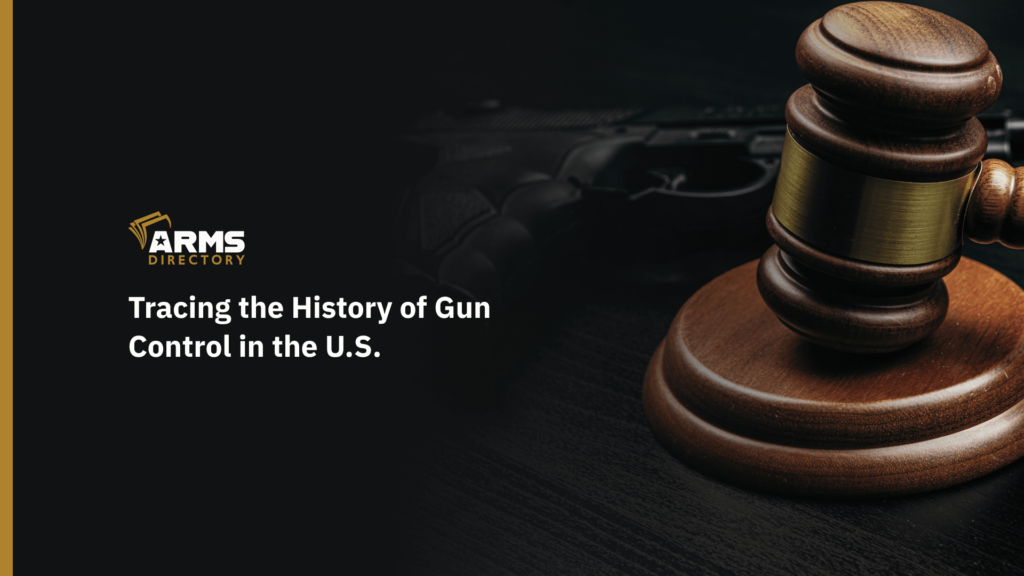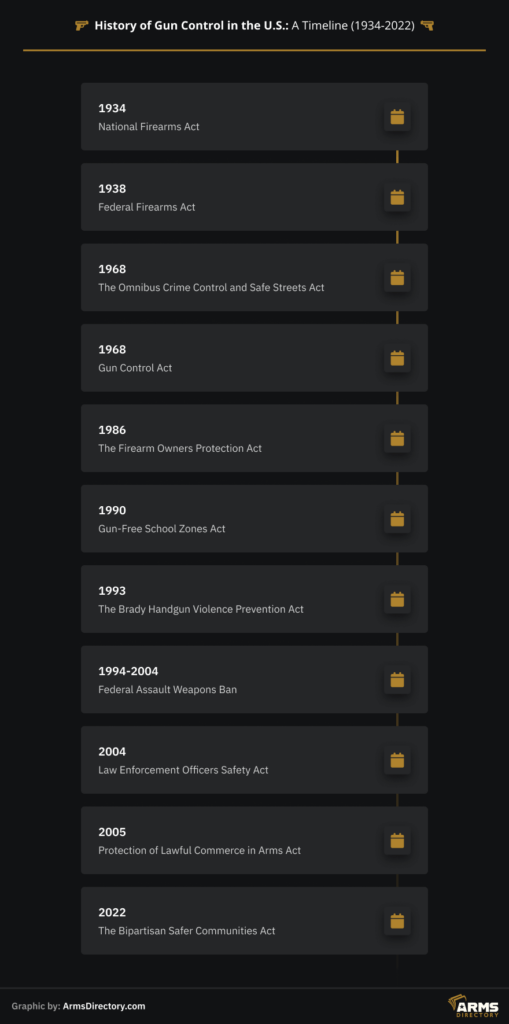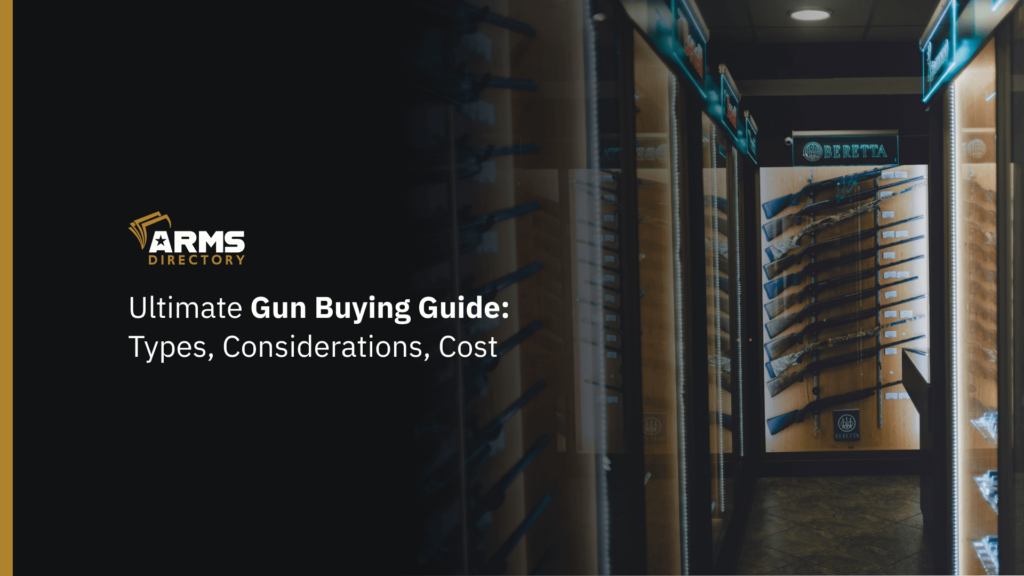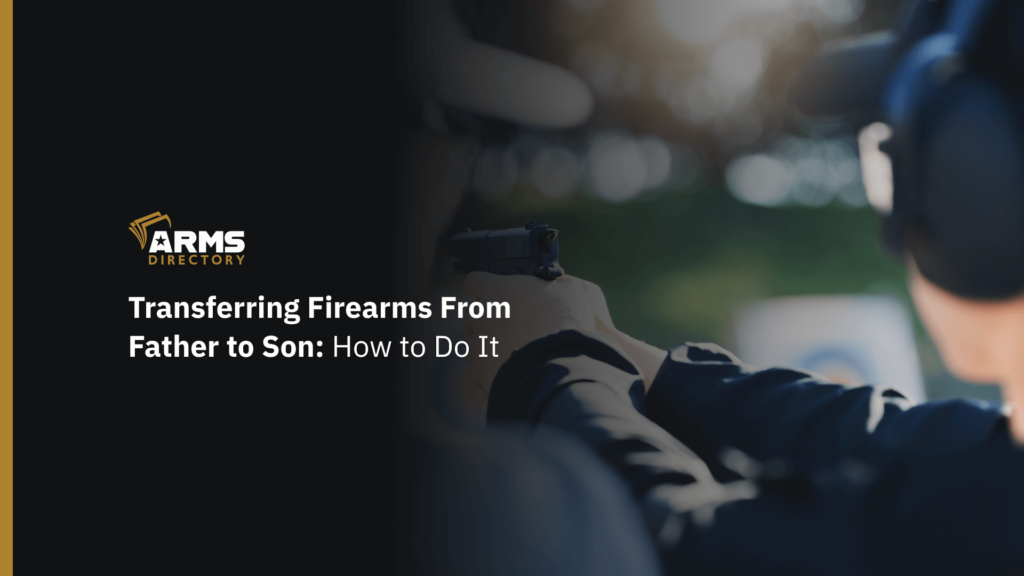
Tracing the History of Gun Control in the U.S.
In 1791, the Second Amendment guaranteed the constitutional right to bear arms, in order to protect yourself against a tyrannical government, and any other potential threat to your personal well-being, and freedom.
However, while this right protects people and their individual freedoms, it can also be a major threat to the safety and welfare of many others.
Unsurprisingly, gun control laws in the U.S. have been revised and updated many times over the decades, in an attempt to ensure a balance between freedom and control.
Let us look at some of the most notable gun control regulations in the history of the United States.
Related Post: The History of Guns: Importance and Timeline – Arms Directory
History of Gun Control in the U.S.: A Timeline (1934-2022)

- National Firearms Act (1934)
- Federal Firearms Act (1938)
- The Omnibus Crime Control and Safe Streets Act (1968)
- Gun Control Act (1968)
- The Firearm Owners Protection Act (1986)
- Gun-Free School Zones Act (1990)
- The Brady Handgun Violence Prevention Act (1993)
- Federal Assault Weapons Ban (1994–2004)
- Law Enforcement Officers Safety Act (2004)
- Protection of Lawful Commerce in Arms Act (2005)
- The Bipartisan Safer Communities Act (2022)
1. National Firearms Act (1934)
One important turning point in the history of gun control in the US was the 1934 National Firearms Act (NFA). This law, which was passed thanks to the growth of organized crime during the Prohibition era, attempted to regulate certain weapons and their associated accessories.
Several limitations were imposed by the NFA on weapons, such as machine guns, shotguns, and rifles with short barrels, silencers, and explosives like bombs and grenades. In order to possess these things, people had to register them with the federal government and pay a tax.
Reducing criminal activity by controlling access to potentially lethal weapons and enacting strict laws governing their ownership and transfer were implemented in an effort to prevent their misuse.
2. Federal Firearms Act (1938)
The Federal Firearms Act of 1938 established background checks and licensing requirements for anybody dealing in interstate firearm transactions.
By requiring licenses, people who sold firearms would be closely monitored and held responsible for their activities. Background checks were also instituted to prevent people with mental health problems or criminal backgrounds from buying guns.
This act’s emphasis on controlling interstate commerce pertaining to the sale of weapons was one of its main features. By imposing federal control over these transactions, the government aimed to provide consistent guidelines and stop illegal trafficking across state lines.
3. The Omnibus Crime Control and Safe Streets Act (1968)
The Omnibus Crime Control and Safe Streets Act of 1968 addressed growing concerns surrounding crime rates and public safety.
Giving federal support to state and local governments in their fight against crime was one of this act’s main goals. It created numerous initiatives to help fund and strengthen crime prevention programs, community safety while enhancing law enforcement organizations.
This act provided the financing for cutting-edge initiatives in the fields of community policing, drug abuse prevention, and juvenile justice. The ultimate goal of these programs was to increase community and law enforcement cooperation so that better crime control strategies could be implemented.
4. Gun Control Act (1968)
#page=1″ target=”_blank” rel=”noreferrer noopener”>The Gun Control Act of 1968 was the first major gun control measure in 30 years. It prohibited interstate shipments of firearms and ammunition to private individuals, as well as, sales of guns to minors, drug addicts and “mental incompetents.”
This was the first time the law forbade people with mental disorders, and convicted felons, from being able to obtain guns.
Additionally, this act strengthened the licensing and record-keeping requirements for gun dealers. Its significance lies in the fact that gun dealers were subject to virtually no systematic investigation up until this time, although a 1938 federal law did establish a fee they had to pay to the government to be a licensed dealer.
Related Post: Gun Registration Requirements by State [What You Need to Know] – Arms Directory
5. The Firearm Owners Protection Act (1986)
Also known as the McClure-Volkmer Act, this gun control law practically undid the restrictions on firearms sellers. It prevented the federal government from maintaining a central database of firearms dealer records.
The act also loosened the requirements for obtaining a federal license for what constitutes as “a business engaging in the sale of firearms”. It also allowed FFLs to temporarily conduct business away from their usual business location, such as at gun shows.
Many considered this act to be a step backwards, opening loopholes for illegal gun trafficking, as it also permitted the sale of ammunition without a license. All this caused some U.S. gun control issues, which had to be addressed later on.
6. Gun-Free School Zones Act (1990)
The Gun-Free School Zones Act of 1990 made it illegal for any individual, except law enforcement, to knowingly possess or discharge a firearm in a school zone.
In this case, “school zone” refers to the property of any public, parochial, or private school and anywhere within 1,000 feet (300 meters) of that property. The penalty for disobeying that law is a fine of up to $5,000 and/or five years maximum of jail time.
In 1995 the Supreme Court ruled the act to be unconstitutional in the United States vs. Lopez case. Thus, the law had to be quickly revised to refer only to guns affected by interstate or foreign commerce.
Related Post: What to Look for Before You Buy Guns Online: 6 Tips to Get Prepped – Arms Directory
7. The Brady Handgun Violence Prevention Act (1993)
The Brady Handgun Violence Prevention Act amended the Gun Control Act of 1968. The law enforced an interim waiting period of 5 days before a licensed importer, manufacturer, or dealer may sell, deliver, or transfer a handgun to an unlicensed individual.
The waiting period only applied in states without an acceptable alternate system of conducting background checks on handgun purchasers. These interim provisions applied between February 28, 1994, and November 30, 1998.
8. Federal Assault Weapons Ban (1994–2004)
The Public Safety and Recreational Firearms Use Protection Act, commonly called the Federal Assault Weapons Ban, prohibited:
- The manufacture, transfer, and possession of semi-automatic assault weapons.
- The transfer and possession of large capacity ammunition feeding devices (firearms capable of holding 10 rounds of ammo or more).
The law banned 19 types of assault weapons and their copies. It also banned semi-automatic guns with military features and the ability to accept a detachable magazine. Shotguns were not included in this list.
The Assault Weapons Ban stipulated that it would expire ten years from its enactment. The Congress allowed the ban to expire on September 13, 2004.
9. Law Enforcement Officers Safety Act (2004)
The Law Enforcement Officers Safety Act (LEOSA) allowed qualified active, retired, or separated Law Enforcement officers carrying photographic governmental agency identification to carry a concealed weapon in any jurisdiction in the U.S. or U.S. Territories regardless of local or state laws.
The definition of “firearm” excluded any machine type gun, firearm silencer, and destructive device. This law caused a U.S. gun control debate. Some people think that wealthy individuals, who don’t have the right to carry concealed weapons, can use it to avoid local laws by giving time and/or money to local authorities and becoming an extra/reserve officer.
Related Post: Outrageous Gun Myths That Really Need To Die – Arms Directory
10. Protection of Lawful Commerce in Arms Act (2005)
In 2005, Congress approved the Protection of Lawful Commerce in Arms Act, granting wide immunity from various lawsuits to producers, sellers, and importers of “qualified products,” which include firearms, ammunition, and components of a firearm or ammunition.
For these objectives, the PLCAA grants universal protection from lawsuits to federally licensed producers, weapons dealers, importers, and companies engaged in the wholesale or retail sale of ammunition. (This protection also applied to some weapons and ammunition industry trade bodies).
The Bipartisan Safer Communities Act (2022)
The Bipartisan Safer Communities was enacted in 2022. It required a more rigorous investigative background check for anyone 18 to 20-year-old wanting to purchase a long gun.
What is more, the measure specified which gun sellers are required to get a federal gun license and undergo background checks.
The Bipartisan Safer Communities Act established federal statutes that explicitly defined and penalized trafficking and straw purchases, and it prohibited any person convicted of a violent misdemeanor against a “current or recent former dating” partner from acquiring any weapons for five years.
Furthermore, the Act allocated funding and support for initiatives like mental health programs, improving access to services and telehealth under Medicaid and CHIP, crisis intervention programs, expansion, and implementation of red flag laws.
Summary
There you have it, folks, a brief history of U.S. gun control from the National Firearms Act (1934) to The Bipartisan Safer Communities Act (2022).
What are your thoughts – Are American gun control laws currently strict enough, or do we need better ones to ensure our safety and wellbeing?
Let us know your opinions in the comments below, and feel welcome to join our community.



![Gun Registration Requirements by State [What You Need to Know]](https://vault.armsdirectory.com/wp-content/uploads/2023/10/27073220/Gun-Registration-Requirements-by-State-What-You-Need-to-Know-1024x576.png)
![The Ultimate Shooting Accessories for Every Weapon [A 2023 Beginners Guide]](https://vault.armsdirectory.com/wp-content/uploads/2023/08/30071223/The-Ultimate-Shooting-Accessories-for-Every-Weapon-A-2023-Beginners-Guide-1024x576.png)
![The Right Way to Buy and Sell Firearms Online [Guide]](https://vault.armsdirectory.com/wp-content/uploads/2023/10/20050323/The-Right-Way-to-Buy-and-Sell-Firearms-Online-Guide-1-1024x576.png)

